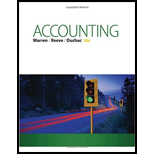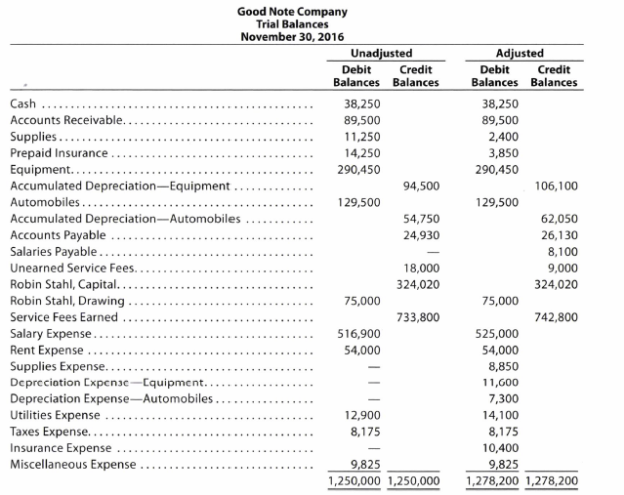
Concept explainers
Good Note Company specializes in the repair of music equipment and is owned and operated by Robin Stahl. On November 30, 2016, the end of the current year, the accountant for Good Note Company prepared the following

Instructions
Journalize the seven entries that adjusted the accounts at November 30. None of the accounts were affected by more than one adjusting entry.
Adjusting entries:
Adjusting entries refers to the entries that are made at the end of an accounting period in accordance with revenue recognition principle, and expenses recognition principle. All adjusting entries affect at least one income statement account (revenue or expense), and one balance sheet account (asset or liability).
Rules of Debit and Credit:
Following rules are followed for debiting and crediting different accounts while they occur in business transactions:
- Debit, all increase in assets, expenses and dividends, all decrease in liabilities, revenues and stockholders’ equities.
- Credit, all increase in liabilities, revenues, and stockholders’ equities, all decrease in assets, expenses.
To prepare: The adjusting entries in the books of Company GN at the end of the year.
Explanation of Solution
An adjusting entry for Supplies expenses:
In this case, Company GN recognized the supplies expenses at the end of the year. So, the necessary adjusting entry that the Company GN should record to recognize the supplies expense is as follows:
| Date | Description | Post Ref. |
Debit ($) | Credit ($) | |
| 2016 | Supplies expenses (1) | 8,850 | |||
| November | 30 | Supplies | 8,850 | ||
| (To record the supplies expenses incurred at the end of the year) | |||||
Table (1)
Working note:
Calculate the value of supplies expense
- Supplies expense decreases the value of owner’s equity by $8,850; hence debit the supplies expenses for $8,850.
- Supplies are an asset, and it decreases the value of asset by $8,850, hence credit the supplies for $8,850.
An adjusting entry for insurance expenses:
In this case, Company GN recognized the insurance expenses at the end of the year. So, the necessary adjusting entry that the Company GN should record to recognize the prepaid expense is as follows:
| Date | Description | Post Ref. |
Debit ($) | Credit ($) | |
| 2016 | Insurance expenses (2) | 10,400 | |||
| November | 30 | Prepaid insurance | 10,400 | ||
| (To record the insurance expenses incurred at the end of the year) | |||||
Table (2)
Working note:
Calculate the value of insurance expense
- Insurance expense decreases the value of owner’s equity by $10,400; hence debit the insurance expenses for $10,400.
- Prepaid insurance is an asset, and it decreases the value of asset by $10,400, hence credit the prepaid insurance for $10,400.
An adjusting entry for depreciation expenses-Equipment:
In this case, Company GN recognized the depreciation expenses on equipment at the end of the year. So, the necessary adjusting entry that the Company GN should record to recognize the accrued expense is as follows:
| Date | Description | Post Ref. |
Debit ($) | Credit ($) | |
| 2016 | Depreciation expenses –Equipment (3) | 11,600 | |||
| November | 30 | Accumulated depreciation-Equipment | 11,600 | ||
| (To record the depreciation expenses incurred at the end of the year) | |||||
Table (3)
Working note:
Calculate the value of depreciation expense-Equipment
- Depreciation expense decreases the value of owner’s equity by $11,600; hence debit the depreciation expenses for $11,600.
- Accumulated depreciation is a contra-asset account, and it decreases the value of asset by $11,600, hence credit the accumulated depreciation for $11,600.
An adjusting entry for depreciation expenses-Automobiles:
In this case, Company GN recognized the depreciation expenses on automobiles at the end of the year. So, the necessary adjusting entry that the Company GN should record to recognize the accrued expense is as follows:
| Date | Description | Post Ref. |
Debit ($) | Credit ($) | |
| 2016 | Depreciation expenses –Automobiles (4) | 7,300 | |||
| November | 30 | Accumulated depreciation-Automobiles | 7,300 | ||
| (To record the depreciation expenses incurred at the end of the year) | |||||
Table (4)
Working note:
Calculate the value of depreciation expense-Automobiles
- Depreciation expense decreases the value of owner’s equity by $7,300; hence debit the depreciation expenses for $7,300.
- Accumulated depreciation is a contra-asset account, and it decreases the value of asset by $7,300, hence credit the accumulated depreciation for $7,300.
An adjusting entry for utilities expenses:
In this case, Company GN recognized the utilities expenses at the end of the year. So, the necessary adjusting entry that the Company GN should record to recognize the accrued expense is as follows:
| Date | Description | Post Ref. |
Debit ($) | Credit ($) | |
| 2016 | Utilities expenses (5) | 1,200 | |||
| November | 30 | Accounts payable | 1,200 | ||
| (To record the utilities expenses incurred at the end of the year) | |||||
Table (5)
Working note:
Calculate the value of utilities expense
- Utilities expense decreases the value of owner’s equity by $1,200; hence debit the utilities expenses for $1,200.
- Accounts payable is a liability, and it increases the value of liability by $1,200, hence credit the accounts payable for $1,200.
An adjusting entry for salaries expenses:
In this case, Company GN recognized the salaries expenses at the end of the year. So, the necessary adjusting entry that the Company GN should record to recognize the accrued expense is as follows:
| Date | Description | Post Ref. |
Debit ($) | Credit ($) | |
| 2016 | Salaries expenses (6) | 8,100 | |||
| November | 30 | Salaries payable | 8,100 | ||
| (To record the salaries expenses incurred at the end of the year) | |||||
Table (6)
Working note:
Calculate the value of salaries expense
- Salaries expense decreases the value of owner’s equity by $8,100; hence debit the salaries expenses for $8,100.
- Salaries payable is a liability, and it increases the value of liability by $8,100, hence credit the salaries payable for $8,100.
An adjusting entry for unearned service fees:
In this case, Company GN received cash in advance before the service provided to customer. So, the necessary adjusting entry that the Company GN should record for the unearned fees revenue at the end of the year is as follows:
| Date | Description | Post Ref. |
Debit ($) | Credit ($) | |
| 2016 | Unearned service fees | 9,000 | |||
| November | 30 | Service fees earned (7) | 9,000 | ||
| (To record the unearned service fees at the end of the year) | |||||
Table (7)
Working note:
Calculate the value of service fees earned
- Unearned service fees are a liability, and it decreases the value of liability by $9,000, hence debit the unearned service fees for $9,000.
- Service fees earned increases owner’s equity by $9,000; hence credit the service fees earned for $9,000.
Want to see more full solutions like this?
Chapter 3 Solutions
ACCOUNTING-W/CENGAGENOWV2 ACCESS
- Please Provide Solution of this General Accounting Question with Correct Methodarrow_forwardWhich of the following accounts is closed at the end of the accounting period? A) RevenueB) DividendsC) ExpensesD) All of the aboveneedarrow_forwardWhich of the following accounts is closed at the end of the accounting period? A) RevenueB) DividendsC) ExpensesD) All of the abovearrow_forward
- I need help Which of the following is considered a non-operating activity? A) Sales revenueB) Interest expenseC) Salaries expenseD) Cost of goods soldarrow_forward13. What is the main purpose of preparing a cash flow statement? A) To show a company's profitabilityB) To show the movement of cash in and out of a companyC) To show the company's net incomeD) To show the total liabilities of the companyarrow_forwardWhich of the following is considered a non-operating activity? A) Sales revenueB) Interest expenseC) Salaries expenseD) Cost of goods soldhelparrow_forward
- Which of the following is considered a non-operating activity? A) Sales revenueB) Interest expenseC) Salaries expenseD) Cost of goods soldarrow_forward16. What is the primary difference between a trial balance and a balance sheet? A) Trial balance includes only liabilitiesB) Trial balance is prepared before financial statementsC) Trial balance includes only assetsD) Balance sheet is prepared daily, while trial balance is prepared monthly no aiarrow_forwardA company’s net income is $50,000, and its total assets are $200,000. What is the company’s return on assets (ROA)? A) 25%B) 20%C) 15%D) 10%arrow_forward
 Financial AccountingAccountingISBN:9781337272124Author:Carl Warren, James M. Reeve, Jonathan DuchacPublisher:Cengage Learning
Financial AccountingAccountingISBN:9781337272124Author:Carl Warren, James M. Reeve, Jonathan DuchacPublisher:Cengage Learning Financial AccountingAccountingISBN:9781305088436Author:Carl Warren, Jim Reeve, Jonathan DuchacPublisher:Cengage LearningCentury 21 Accounting Multicolumn JournalAccountingISBN:9781337679503Author:GilbertsonPublisher:Cengage
Financial AccountingAccountingISBN:9781305088436Author:Carl Warren, Jim Reeve, Jonathan DuchacPublisher:Cengage LearningCentury 21 Accounting Multicolumn JournalAccountingISBN:9781337679503Author:GilbertsonPublisher:Cengage College Accounting (Book Only): A Career ApproachAccountingISBN:9781337280570Author:Scott, Cathy J.Publisher:South-Western College Pub
College Accounting (Book Only): A Career ApproachAccountingISBN:9781337280570Author:Scott, Cathy J.Publisher:South-Western College Pub College Accounting (Book Only): A Career ApproachAccountingISBN:9781305084087Author:Cathy J. ScottPublisher:Cengage Learning
College Accounting (Book Only): A Career ApproachAccountingISBN:9781305084087Author:Cathy J. ScottPublisher:Cengage Learning





